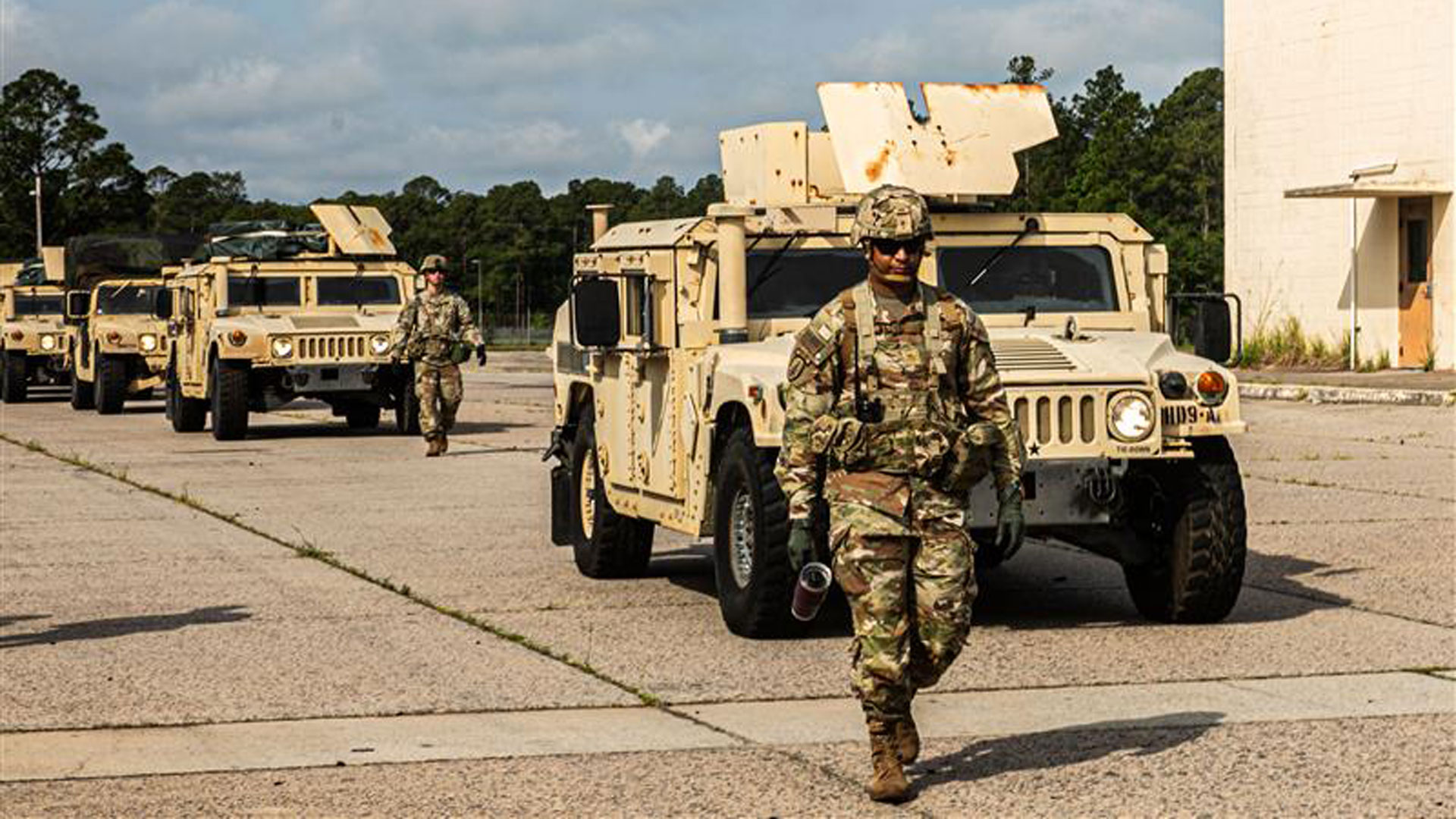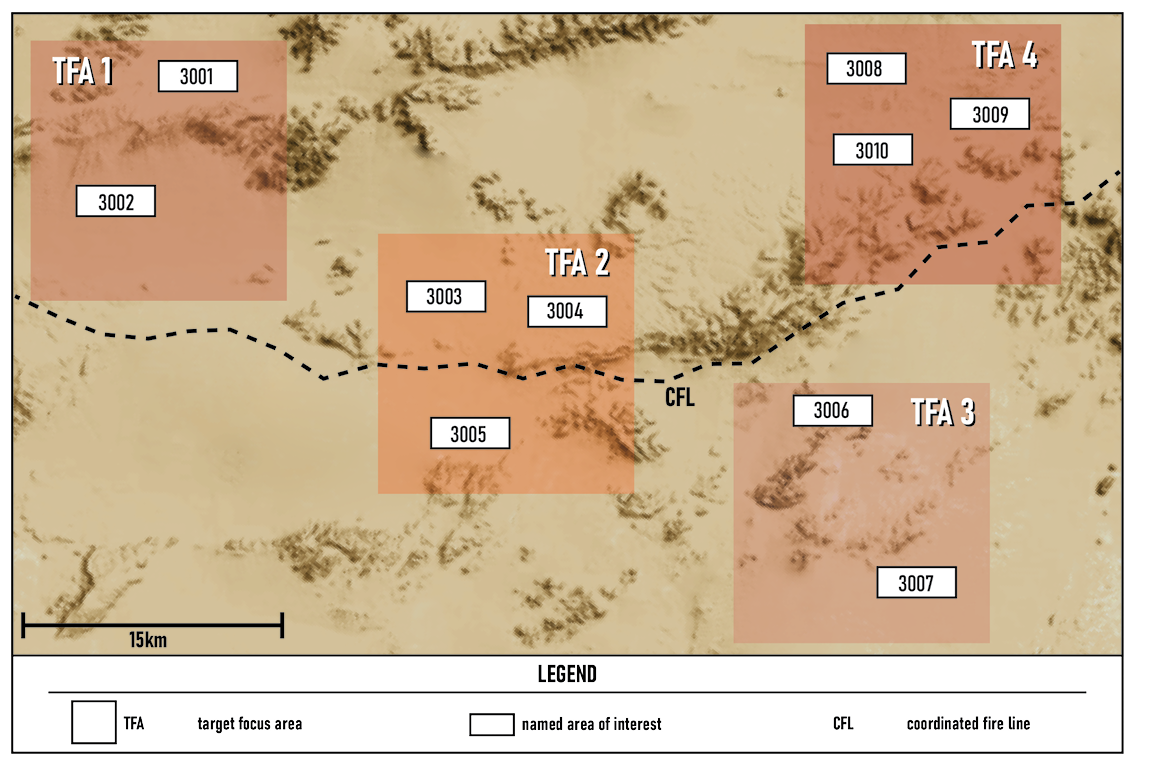Intelligence and Fires Capabilites Integration
By Major General Christopher Norrie, Colonel Shawn Bault, Lieutenant Colonel Marcus O’Neal, Major John Hornecker, and Captain Xavier Ehresman
Article published on: January 1, 2025 in the Military Intelligence Continuous Transformation Special Edition
Read Time: < 8 mins

U.S. Army Soldiers assigned to the 103rd Intelligence and Electronic Warfare Battalion begin a convoy movement to the Mission Training Complex at Fort Stewart, Georgia. (U.S. Army photo)
Introduction
The Army is transitioning and adapting to the multidomain threat and requires updated processes and procedures to maintain an edge over future adversaries. The current conflict in Ukraine demonstrates that successful operations and survivability in a deliberate and dynamic fight depend on an army’s ability to target expeditiously. The 3rd Infantry Division (ID) tested this concept using a strike cell within its division artillery (DIVARTY) to determine if the strike cell could focus the DIVARTY on a portion of the division’s targeting requirements. This would enable the division’s joint air-ground integration cell (JAGIC) to maintain focus on deep shaping operations. This strike cell concept proved its value during a recent command post exercise (CPX), where the Army’s first DIVARTY strike cell enhanced division effects.
Testing the Strike Cell Concept
While deployed in the European theater, Soldiers from the 3rd Infantry Division Artillery (3DIVARTY) and the 103rd Intelligence and Electronic Warfare (IEW) Battalion (BN), in coordination with the 3rd ID Headquarters, conducted CPX III in preparation for Austere Challenge 24 (March 2024), a multinational exercise for the V Corps, with support from the 3rd ID and 3DIVARTY.
CPX III simulated the complexities of conducting command and control, maneuver, fires, and intelligence operations in a large-scale combat operations environment. It also tested both the division and subordinate commands’ ability to conduct command and control of assigned formations and the 3DIVARTY’s ability to synchronize fires and deliver lethal effects. The 103rd IEW BN Soldiers were integrated into the 3DIVARTY intelligence section to enhance the unit’s target acquisition capabilities and reduce the time from sensor to shooter.
“The Strike Cell integration into 3DIVARTY is a force multiplier that enables effects continuity throughout the division battlespace from the division forward boundary to brigades’ front-line trace.”
—COL Shawn Bault, 3DIVARTY Commander
The 3DIVARTY received the following capabilities for CPX III: a processing, exploitation, and dissemination (PED) element; a battle damage assessment team; an intelligence, surveillance, and reconnaissance assessment team; and mission manager support to assume responsibility for current collection operations management, freeing the 3DIVARTY intelligence section’s officer in charge to focus on providing intelligence analysis and situational awareness.
The 3DIVARTY strike cell comprised a geospatial intelligence imagery analyst to monitor full-motion video and ground movement target indicator feeds and a signals intelligence analyst to monitor and analyze signal and communications data.1 A mission manager2 and a field artillery intelligence officer3 led strike cell operations. This combined effort facilitated a consistent focus on deliberate and dynamic targeting within the DIVARTY.
The 3rd ID uses target focus areas (TFAs)4 to support targeting operations. Each TFA is a 15-kilometer by 15-kilometer square comprising a geographic grouping of target areas of interest and named areas of interest, which are anticipated to contain many high-payoff targets. The division actively targets the deepest TFAs beyond the coordinated fire line (CFL) and assigns the TFA nearest to the CFL to 3DIVARTY. Each TFA is assigned to a strike cell in the division’s deep area, approximately 25 to 45 kilometers beyond the CFL, pending firing assets and munitions available. This practice was validated during CPX III and will be applied in future operations.

Figure. Example Target Focus Area
The 3DIVARTY, in close coordination with the division fires, the division G-2, and the 103rd IEW BN, used DIVARTY capabilities to detect, deliver, and assess targets. This enabled the rapid employment of surface-to-surface fires, decreased target decay times, and ultimately allowed the JAGIC, the strike cell, and the G-2 analysis and control element to maintain focus on deep area shaping operations. The 3DIVARTY passed objectives to the brigade combat teams to maintain constant pressure on simulated enemy formations. The 3DIVARTY then focused on TFAs with their strike cell to enable prioritizing the division’s TFA nearest to the CFL. This maximized division effects and permitted the JAGIC to focus on the division’s deep fight with long-range and joint fires capabilities.
“The IEW Battalion provides the Division’s Artillery element with an expeditionary intelligence capability that bolsters the intelligence capacity of the S-2 staff, allowing for targeting efforts independent of the Division’s JAGIC.”
—COL Marcus O’Neal, 103rd IEW BN.
The 3DIVARTY strike cell provided effective PED support to the field artillery intelligence officer and the fire support element’s targeting efforts. The synchronization between the DIVARTY fire support element and the JAGIC was paramount in clearing airspace to ensure timely and accurate fires. The DIVARTY air defense airspace management/brigade aviation element assisted the JAGIC in expeditiously clearing airspace for fires after the division allocated a TFA to DIVARTY. In turn, the JAGIC supported DIVARTY in deconflicting airspace above the coordinated altitude by using airspace control measures to rapidly execute fires.
Conclusion
The 3DIVARTY strike cell proved to be a critical capability, directly impacting division shaping operations and enabling division transitions across the battlefield. Through CPX III, the 3DIVARTY validated the strike cell concept. The 3DIVARTY strike cell, along with existing 3DIVARTY systems and the 103rd IEW BN, was central to the success of targeting operations. The strike cell led the fight when the division main and tactical command posts jumped, enabling a smooth transition and maintaining division effects. Additionally, the 103rd IEW BN accomplished its mission of providing additional intelligence analysis and collection capabilities to a division—the Army’s unit of action in a large-scale combat operation scenario—enhancing the overall capability of the division’s intelligence elements and ensuring lethality for maneuver elements.
"Our DIVARTY Strike Cell is critical to maintaining lethal contact to keep the combine5 churning up ground as we transition contact to maneuver brigades.” said MG Christopher Norrie, 3rd ID Commanding General.
Endnotes
1.. Joint Chiefs of Staff, Joint Publication 2-0, Intelligence (Washington, DC: U.S. Government Publishing Office [GPO], 26 May 2022), GL-22. Change 1 was issued on 5 July 2024. Signals intelligence is intelligence derived from communications, electronic, and foreign instrumentation signals.
2. The mission manager ensured the geospatial intelligence imagery analyst and signals intelligence analyst cued each other, tasked the unmanned aircraft system operator with dynamic movements, and communicated with the division for updated nonlethal effects and theater support. The mission manager also managed the collection plan focused on the high-payoff target list assigned by the division fire support element.
3. . Department of the Army, Field Manual 3-09, Fire Support and Field Artillery Operations (Washington, DC: GPO, 12 Aug 2024), 2-3, 2-7–2-8. The field artillery intelligence officer communicated with the division artillery fires support element fire control officer by sending validated targets for the fire control officer to engage. Additionally, with support from the strike cell, the field artillery intelligence officer contributed to target asseessment (battle damage, munitions effectiveness, and re-attack recommendations).
4. Target focus areas are a non-doctrinal concept and term used by the 3rd Infantry Division to support its targeting operations.
5. The term combine describes how the 3rd ID places numerous effects on the enemy, simultaneously or sequentially, forcing a commander to make a choice between multiple unappealing options.
Authors
MG Christopher Norrie is the Commanding General, 3r d Infantry Division (ID), Fort Stewart, GA. He previously served as the Director, People First Task Force, Office of the Deputy Chief of Staff, G-1. He has held multiple command and other assignments within 1st Cavalry Division, 1st Armored Division, 1st ID, 4th ID, the Training and Doctrine Command, and Headquarters, Department of the Army staff. His operational deployments and combat tours include Operation Joint Forge, Operation Iraqi Freedom, Operation Spartan Shield, and Operation Atlantic Resolve. His military education includes the U.S. Army Armor Officers Basic Course, Infantry Officer Advanced Course, and the Command and General Staff College. MG Norrie is a distinguished military graduate of Bucknell University in Lewisburg, PA, and holds master’s degrees in business administration from Embry-Riddle University and in national security strategy from the National War College.
COL Shawn Bault is the Commander, 3rd ID Artillery, Fort Stewart, GA. He previously served in the Pentagon as Chief of Staff for the Chief of Army Public Affairs. He deployed multiple times in support of Operations Enduring Freedom, Iraqi Freedom, Spartan Shield, Inherent Resolve, and European Assure, Deter, and Reinforce. COL Bault’s military education includes the National War College, the School of Advanced Military Studies, the Command and General Staff College, Joint Firepower Control Course, Air Assault School, and Advanced Airborne School. He holds a bachelor’s degree in history from the U.S. Military Academy and a master’s degree in kinesiology from Texas A&M University.
COL Marcus O’Neal is the Director (J-2) Special Operations Command South, Homestead Air Reserve Base, FL. He previously served as the Commander, 103rd Intelligence and Electronic Warfare (IEW) Battalion, Fort Stewart, GA. COL O’Neal deployed several times throughout his career. He deployed to Iraq as both an armor and intelligence officer and to Afghanistan as an intelligence officer. COL O’Neal graduated as a distinguished military graduate from Southern University, Baton Rouge, LA. He holds a master of science of strategic intelligence from the National Intelligence University.
MAJ John Hornecker is the 3rd ID Deputy G-2, Fort Stewart, GA. He previously served as the 3rd ID Collection Manager and 3rd ID Artillery Brigade S-2 in support of Operation European Assure, Deter, and Reinforce (Latvia). MAJ Hornecker previously deployed in support of Operation Spartan Shield from June 2012–March 2013. His professional accomplishments include completion of the Army Intelligence Development Program-Intelligence, Surveillance, and Reconnaissance program. MAJ Hornecker is a graduate of Saint Louis University.
CPT Xavier Ehresman is the 3rd ID G-2 Targeting Officer. He previously served as the Commander, Bravo Detachment, 103rd IEW Battalion, Fort Stewart, GA. Prior to company command, he served as an infantry platoon leader and battalion assistant S-2 at Fort Drum, NY, and as a battalion S-2 for the 103rd IEW Battalion. He holds a bachelor’s degree in forensic psychology with a focus in psychology from the University of New Haven. He is currently pursuing a master’s degree in human performance and nutrition from Liberty University.